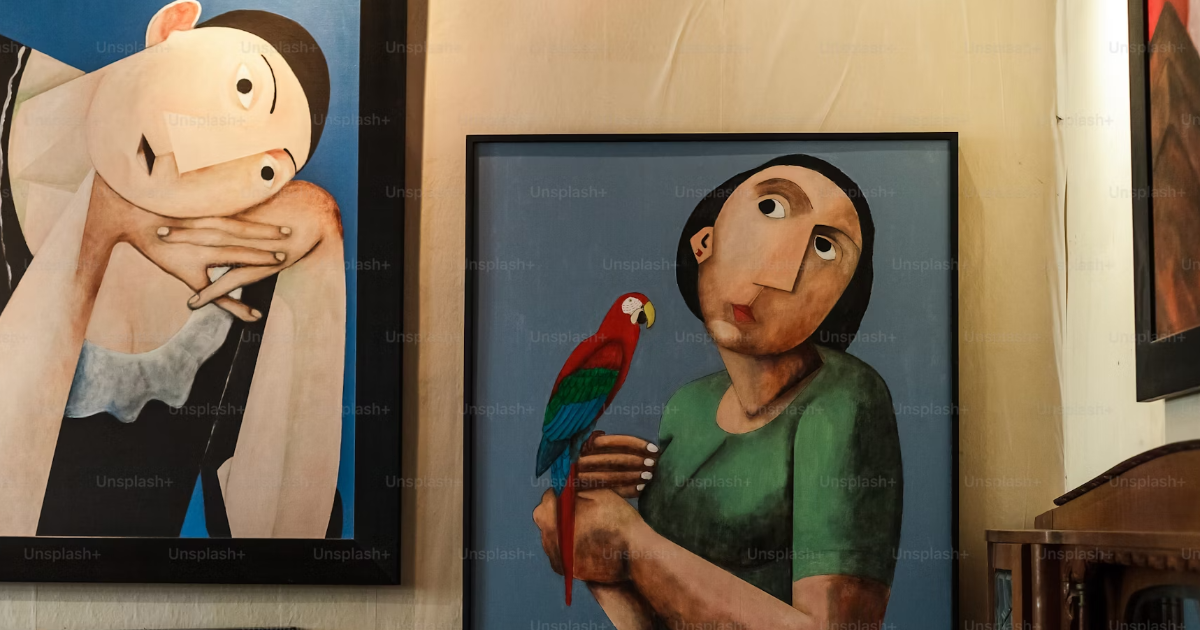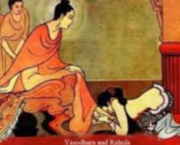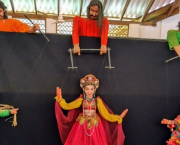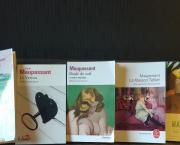
Representation of Dominating Women in Guy de Maupassant's Short Stories
 21 min
21 min
Representation of Dominating Women in Guy de Maupassant's Short Stories
I
walk into a room
Just as cool as you please,
And to a man,
The fellows stand or
Fall down on their knees.
Then they swarm around me,
A hive of honey bees.
(Phenomenal
Woman, by Maya Angelou)
This article examines the depiction of dominating female characters in Maupassant's short stories by closely examining selected short narratives. This study aims to explore the motivational source, personal traits and social impact of the depiction of women in Maupassant's writings in order to reveal examples of female characters claiming control, power, and control over others.
Guy de Maupassant, eminent 19th century French author, is known for his realistic portrayal of various social and human affairs. In his extensive collection of short stories, Maupassant has created female characters who display strong attitudes and behaviors and challenge gender roles and expectations in his era.
This analysis focuses on the images of the main women in Maupassant's story, considering the emotions behind their actions and the consequences of their control. The analysis includes the characters' performances, dialogues, interactions with other characters, and narrative elements to understand the representation of key women.
« Selon Maupassant, elles seules peuvent incarner la véritable féminité et ensorceler l'homme par leur charme et leur beauté, puisqu'en effet la femme du monde a fait de sa vie un interminable jeu de séduction. Coquette dans l'âme, elle use de son corps pour attirer les hommes qu'elle envoûte par ses regards. Ce combat interrompu constitue sa principale raison de vivre et elle a acquis une maîtrise totale dans l'art de séduire. »[i]
(According to Maupassant, only women can embody true femininity and enchant the man with their charm and beauty, since indeed the woman of the world has turned his life into an endless game of seduction. Coquettish in soul, she uses her body to attract men whom she enchants with her gaze. This interrupted battle constitutes her main reason for living, and she has acquired complete mastery in the art of seduction.)
Primarily, Maupassant portrays dominating women who exhibit assertiveness and employ manipulative tactics to achieve their desired goals. These characters often use their intelligence, wit, and charm to manipulate and control those around them. Defined by their charming beauty and magnetic charisma, they adeptly influence men thereby establishing authority over their situations.
An illustrative example can be found in “L’Épingle”(The Pin) where the female protagonist exercises control over her lover's finances, using her demeanor and smile to manipulate him into financial ruin.
« Cette fille m’a ruiné en trois ans. Je possédais quatre millions qu’elle a mangés de son air calme, tranquillement, qu’elle a croqués avec un sourire doux qui semblait tomber de ses yeux sur ses lèvres. »[ii]
(This girl ruined me in three years. I had four million that she devoured with her calm demeanor, quietly, that she nibbled with a sweet smile that seemed to flow from her eyes to her lips.)
On the other hand, there are women who are extremely careful with their finances and have a complete control over the expenses. In the short story “Le Parapluie”( The Umbrella), Madame Oreille's most prominent characteristic is her frugality and extreme careful approach to managing finances. She values money and possesses a set of strict principles that guide her decisions regarding spending and saving. This trait defines her behavior and mindset, leading her to be cautious and deliberate in her financial choices.
«Madame Oreille était économe. Elle savait la valeur d’un sou et possédait un arsenal de principes sévères sur la multiplication de l’argent. Sa bonne, assurément, avait grand mal à faire danser l’anse du panier ; et M. Oreille n’obtenait sa monnaie de poche qu’avec une extrême difficulté. Ils étaient à leur aise, pourtant, et sans enfants ; mais Mme Oreille éprouvait une vraie douleur à voir les pièces blanches sortir de chez elle. C’était comme une déchirure pour son cœur ; et,
chaque fois qu’il lui avait fallu faire une dépense de quelque importance, bien qu’indispensable, elle dormait fort mal la nuit suivante. »[iii]
“Madame Oreille was thrifty. She knew the value of a penny and possessed an arsenal of strict principles regarding the multiplication of money. Her maid, surely, had a great deal of trouble making the basket handle dance; and Mr. Oreille only obtained his pocket money with extreme difficulty. They were comfortable, nonetheless, and childless; but Madame Oreille felt genuine pain at seeing the silver coins leave her home. It was like a tear in her heart; and every time she had to make
an expense of some importance, though necessary, she slept very poorly the following night."
Another dominating characteristic is her strong emotional attachment to money. She experiences genuine distress when money is spent, particularly on significant expenses. This emotional connection to her wealth reflects her deep-seated reluctance to part with her earnings, even when necessary. Madame Oreille's emotional attachment to money leads to internal conflicts and anxiety. She suffers from sleep disturbances when she has to make significant but necessary expenses. This suggests that her concern for financial security and her emotional turmoil create a source of inner tension and stress.
Furthermore, Maupassant's meticulous descriptions of the characters effectively exhibit the dominant nature of these women in his stories. For instance, in "La patronne" (The Boss),
« Mme Kergaran avait quarante ans environ. Elle était forte, très forte, parlait d’une voix de capitaine instructeur et décidait toutes les questions d’un mot net et définitif. »[iv]
“Mme Kergaran was about forty years old. She was strong, very strong, spoke with the voice of a drillsergeant, and decided all matters with a clear and definitive word.”
Such depictions by attributing “masculine” characteristics of the era such as strength and command, vividly capture the essence of their dominance, rendering their characters indelibly engraved in the reader's perception.
Maupassant also employs the portrayal of dominating women as a means of critiquing societal norms and gender expectations prevalent in his era. These women, who challenge conventional roles, serve as vehicles through which Maupassant interrogates established power structures and dissects the intricacies of gender dynamics in the 19th century France.
This can be seen in the character of Madame Tellier in "La Maison Tellier," (The Tellier House) who manages a brothel while maintaining a respectable reputation within the community, challenging societal expectations. Madame Tellier is depicted as a strong and independent woman who owns a popular brothel. She is the central figure in her establishment, and her presence plays a significant influence on the lives of her employees and the clients who visit the brothel. Despite her
profession, she is respected by the townspeople, showcasing her ability to practice her authority and maintain a respectable reputation.
« l’on prenait sa chartreuse en lutinant quelque peu les filles, ou bien on causait sérieusement avec Madame, que tout le monde respectait […] Madame, depuis son veuvage, était vainement désirée par tous les habitués de l’établissement ;
mais on la disait absolument sage, et ses pensionnaires elles-mêmes n’étaient parvenues à rien découvrir. »[v]
“One would enjoy their Chartreuse while playfully flirting with the girls, or engage in serious onversations with Madame, whom everyone respected [...] Since becoming a widow, Madame had been ardently desired by all the regulars of the
establishment, yet she was reputed to be completely virtuous, and even her boarders had failed to uncover anything.”
In the short story “La fênetre" (The window) Madame de Jadelle is portrayed as a complex and independent woman in contrast to weak women in a patriarchal 19th century French society.
« Vous savez comme elle est fantasque et poétique en même temps. Libre d’allures et de cœur impressionnable, volontaire, émancipée, hardie, entreprenante, audacieuse, enfin au-dessus de tout préjugé, et, malgré cela, sentimentale, délicate, vite
froissée, tendre et pudique. »[vi]
“You know how she is whimsical and poetic at the same time. Free-spirited in her demeanor and impressionable
in her heart, determined, independent, bold, enterprising, daring, ultimately beyond all prejudice, and yet, despite all that, sentimental, delicate, easily hurt, tender, and modest.”
Madame de Jadelle's character is a tapestry woven with diverse threads. Described as both "fantasque" (whimsical) and "poétique" (poetic), she exhibits a creative and imaginative dimension that hints at her unique outlook on the world. Her free-spirited nature, captured in being "libre d’aillures" (free-spirited) and having an "cœur impressionnable" (impressionable
heart), signifies an openness to new experiences, emotions, and perspectives. She embraces the unknown with a receptive and embracing spirit, unafraid to immerse herself in the world around her. Yet, her qualities extend beyond these
traits. She is "émancipée" (emancipated) and "hardie" (bold), breaking free from societal norms and embracing her independence with a fearless determination. Her strong nature is balanced by her "sentimentale" (sentimental) and
"délicate" (delicate) nature, revealing the depth of her emotional capacity. Her profound connections to her feelings and her ability to form deep bonds reflect a multifaceted personality.
In her approach to marriage, Madame de Jadelle showcases both practicality and thoughtfulness. Rather thansettling for an arranged marriage as it was popular for many ladies in the era, she emphasizes the importance of comprehending her potential partner's soul before committing, reflecting a sensible understanding of compatibility andstability. Moreover, her proposal to spend extended time in each other's presence at her property, Lauville, speaks to her intellectual and analytical acumen. This act reveals an earnest desire for a profound understanding of her partner beyond the realm of fleeting emotions. Rooted in self-respect, Madamede Jadelle's disdain for conventional love highlights her resolve to prioritize her emotional well-being. By expressing her aversion to love as it is often perceived, she underscores the value she places on her autonomy and emotional independence. This sentiment underlines the strength of her character and
serves as a testament to her enduring principles. This analysis sheds light on the intricate layers of Madame de Jadelle's character, encapsulating her vibrant personality and the underlying motivations that drive her actions and decisions.
Madame Loisel is one of Maupassant's most well-known characters in "La Parure” (The Necklace),
« Elle n’avait pas de toilettes, pas de bijoux, rien. Et elle n’aimait que cela ; elle se sentait faite pour cela. Elle eût tant désiré plaire, être enviée, être séduisante et recherchée. »[vii]
(She had no dresses, no jewelry, nothing. And that's all she loved; she felt made for that. She so longed to please, to be envied, to be charming and sought after.)
Madame Mathilde Loisel is portrayed as a woman who desires a higher social status and material wealth. She dominates her husband's thoughts and actions, making him sacrifice his own desires to fulfill her extravagant wishes. Her insatiable desire for luxury and social recognition becomes the driving force of the story, leading to the couple's downfall. Her desire to be part of the upper class and her dissatisfaction with her own life lead her to borrow a costly necklace for a party, only to lose it. The subsequent deception and attempts to replace the necklace drive the narrative, showcasing the consequences of her actions. While Madame Loisel's behavior can be seen as manipulative, it stems from her desire to fit into a society she perceives as superior.
The presence of dominating women in Maupassant's stories often has significant effects on other characters. Their actions can lead to manipulation, emotional turmoil, or even destruction for those who fall under their influence. The influence of
dominating women resonates beyond their immediate actions, often resulting in manipulation, emotional upheaval, or even devastation for those ensnared in their grasp. This ripple effect emphasizes the profound impact of their dominance on the narrative.
In "La Mère aux Monstres," (Monstrous mother) the mother's dominance manifests through her callous manipulation of her children's deformities, which engenders societal repulsion and underlines the tragic consequences of her actions.
« C’est une femme abominable, un vrai démon, un être qui met au jour chaque année, volontairement, des enfants difformes, hideux, effrayants, des monstres enfin, et qui les vend aux montreurs de phénomènes. »[viii]
"She's a dreadful woman, a true demon, someone who deliberately gives birth every year to deformed, hideous, frightening children—monsters, in short—and then sells them to sideshow exhibitors."
The story revolves around a woman known as "La Mère aux Monstres," who deliberately gives birth to deformed and monstrous children, selling them to showmen for profit. The mother's dominance is evident in several ways. The mother controls her body and pregnancies with a ruthless determination. She uses a homemade corset to deform her unborn child, intentionally creating monstrous deformities. This illustrates her complete dominance over her own body and her willingness to manipulate it for her own gain. Her total control over her own body portrays an echo of feminist discourse that was budding in late Nineteenth century Europe. The mother's decision to create these monstrous children is motivated by financial gain. She capitalizes on the grotesque appearances of her children, selling them to showmen who exhibit them for money. Her focus on profit highlights her dominance over ethical considerations and the well-being of her offspring.
The mother's willingness to deform and sell her children reflects a disturbing disregard for their well-being. She is more concerned with her own appearance, beauty, and the money she can gain from her actions. This underscores her dominance over maternal instincts and her ability to prioritize her own interests above all else.
Society's judgment of the mother as "La Diable" (The Devil) highlights her dominating presence. Her actions are so extreme and her children so deformed that they evoke fear and repulsion. This societal labeling further emphasizes her dominance as a figure that defies norms and morality. Even when faced with societal criticism and disapproval, the mother remains dominant. She haggles over prices, defies societal norms, and continues to reproduce monstrous children for profit. Her
unyielding determination in the face of criticism show cases her power and control over her actions.
In "La Mère aux Monstres," the mother's dominance is depicted as a force that not only affects her own life but also tragically shapes the lives of her deformed children. The story explores the complex intersection of power, morality, and personal motivations, ultimately revealing the disturbing consequences of unchecked dominance.
In conclusion, in Guy de Maupassant's short stories, the representation of dominating women challenges traditional gender roles and expectations set by patriarchal society. Hence, the author takes a pioneering pro-feminist approach in his portrayal. These female characters exhibit assertiveness, manipulation, and a desire for power, questioning societal norms and power dynamics. While their dominance may bring temporary control, it also carries consequences and raises questions about the complexities of power and gender relations. Further analysis and examination of additional stories would contribute to a deeper understanding of Maupassant's intentions and the broader implications of his representation of dominating women in his works.
Therefpre, these female characters, fueled by ambition and wielding manipulation, challenge conventions while navigating the fine line between power and consequences. This analysis underscores the depth of Maupassant's exploration, inviting further inquiry into the myriad layers of his depiction of dominating women in his literary legacy.
[i] Lenoir Agnès. Maupassant et les femmes du monde. In: Études Normandes, 43e année, n°2, 1994. Maupassant du réel
au Fantastique. pp. 25-34; https://www.persee.fr/docAsPDF/etnor_0014-2158_1994_num_43_2_2132.pdf
[ii] L’épingle. Texte publié
dans Gil Blas du 13 août 1885, sous la signature de Maufrigneuse, puis publié dans le recueil Monsieur Parent (pp. 199-211). Il a également été repris dans La Vie populaire du 25 février 1886, dans Le nouveau Décaméron, 10ème journée (pp. 176-186), dans L’Intransigeant illustré du 8 octobre 1891 et dans le supplément littéraire illustré du Petit Parisien du 17 janvier 1892.
http://maupassant.free.fr/textes/epingle.html
[iii] Le parapluie. Texte publié dans Le Gaulois du 10 février 1884, puis publié dans le recueil Les sœurs Rondoli (pp. 197-217). Il
a également été repris dans La Vie populaire du 25 janvier 1885, dans La Semaine populaire du
27 mars 1887, dans La Lecture du 10 avril 1889, dans L’Intransigeant illustré du 10 septembre 1891 et dans Le Magasin littéraire de mars 1893. Vous pouvez consulter la version illustrée par René Lelong, aux éditions P. Ollendorff, 1907.
[iv] La patronne. Texte publié dans Gil Blas du 1er avril 1884, sous la signature de Maufrigneuse, puis publié dans le recueil Les sœurs Rondoli (pp. 67-83). Il a également été repris dans La Lune troyenne du 25 novembre 1888, dans le supplément
littéraire de La Lanterne du 27 juin 1889 et dans Gil Blas illustré du 1er janvier 1893. Vous pouvez consulter la version illustrée par René Lelong, aux éditions P. Ollendorff, 1907.
[v] La maison Tellier. Texte publié pour la première fois dans le recueil auquel il donne son nom, La maison Tellier (pp. 1-65), paru le 21 avril 1881. Il a également été repris dans le supplément littéraire de La Lanterne du 3
au 21 février 1889, dans Gil Blas illustré des 9, 16 et 23 octobre 1892 et dans le recueil Contes choisis (pp. 1-44), paru en octobre 1892. Vous pouvez consulter la version illustrée par René Lelong, aux éditions P. Ollendorff, 1899.
[vi] La fenêtre. Texte publié dans Gil Blas du 10 juillet 1883, sous la signature de Maufrigneuse, puis publié dans le recueil Le rosier de Madame Husson (pp. 293-310). Il a également été repris dans Le nouveau Décaméron, 3ème journée (pp. 55-65) et dans La Lune troyenne du 28 octobre 1888.
[vii] La parure. Texte publié dans Le Gaulois du 17 février 1884, puis publié dans le recueil Contes du jour et de la nuit (pp. 71-93). Il a également été repris dans Le Voleur du 19 juin 1884, dans La Vie populaire du 7 mai 1885, dans le recueil L’héritage (n°
64 de la collection « Auteurs célèbres » chez Marpon et Flammarion, 1888), dans les Annales politiques et littéraires du 6 octobre 1889, dans le supplément littéraire illustré du Petit Parisien du 14 décembre 1890 et dans le recueil Trois
contes (n° 271 de la « Nouvelle bibliothèque populaire », 1892).
[viii] La mère aux monstres. Texte publié dans Gil Blas du 12 juin 1883, sous la signature de Maufrigneuse, puis publié dans le recueil Toine (pp. 275-289). Il a également été repris dans La Vie populaire du 5 août 1886.









 English
English
 Français
Français
 Deutsch
Deutsch
 Italiano
Italiano
 Español
Español



 Contribuer
Contribuer
























 Tu peux soutenir les auteurs qui te tiennent à coeur
Tu peux soutenir les auteurs qui te tiennent à coeur





